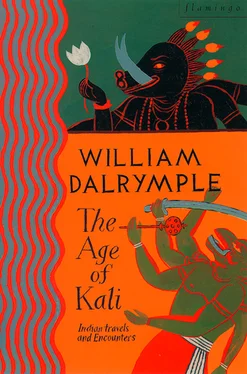Sardar Angre was spared more embarrassment by one of the bearers bringing in a great pile of the morning’s papers. He and the Rajmata began scanning the headlines.
‘Riots, riots, riots,’ said the Rajmata. ‘Every day it is the same.’
Sardar Angre was however engrossed in a report in a Hindi newspaper concerning the latest episode of his own long-standing feud with the Rajmata’s son. The dispute, which had been going on for some fifteen years – and which had, since its outset, been closely followed by the whole country – was currently enjoying one of its periodic flare-ups. Sardar Angre read the report out to the Rajmata.
‘This is all my fault,’ said the Rajmata, shaking her head. ‘A mother’s weakness.’
I must have looked a little confused by all this, for I was immediately treated to a résumé of the whole celebrated affair. In 1975, when Mrs Gandhi locked up the opposition, suspended the Constitution and declared the Emergency, the Rajmata found herself transferred from the splendours of Gwalior to the less familiar surroundings of the infamous Tihar jail near Delhi. Her son, however, did a deal with the Congress and escaped to Nepal, leaving the Rajmata to fester in prison. She has never forgiven him. Moreover, as a minister in the current Congress government, the Maharajah remains a political as well as a personal adversary, the battle within the divided family mirroring the political divide of the nation at large.
‘He did not fight the people who imprisoned his own mother,’ growled Sardar Angre. ‘He should have gone underground and joined the resistance against Mrs Gandhi. Instead he totally surrendered. Nobody in this great family has ever done that. He betrayed his own ancestors.’
‘When he was in power Sardar Angre’s house was attacked [by the police, apparently acting on Mahadav Rao’s orders]. Half his possessions were taken, photographs were smashed …’
‘My two Rottweillers were shot dead …’
‘But worst of all,’ continued the Rajmata, ‘in the Emergency he left me inside that jail with the criminals and prostitutes. Imagine it: one of the inmates had twenty-four cases against her, including four murders. These were the companions he thought suitable for his mother.’
‘How did you cope in jail?’ I asked.
‘I had faith in my Hanumanji,’ replied the Rajmata. ‘He sent help.’
‘Hanuman came to you in person?’ I asked.
‘No,’ replied the Rajmata, sighing and shaking her head sadly. ‘But He spoke within me and showed me that all human beings – even the most hardened criminals – will respond if you show them affection.’
The Rajmata raised her eyes to heaven:
‘And He was quite right, you know: they did. One murderer became my cook – I don’t think I’ve ever had such a faithful servant. I wept when I finally left the prison – I was leaving so many close friends.’
From the front hall a bearer appeared and whispered in the Rajmata’s ear. She nodded, dabbed her mouth with a napkin and got up.
‘I have to go,’ she said. ‘There are some ladies here to see me.’
She added: ‘Sardar Angre would, I’m sure, be pleased to show you around.’
Sardar Angre duly took me around the palace.
I followed him through room after room, hall after hall – great prairies of marble reflected back and forth by tall Victorian pier-glass mirrors.
Upstairs, all was rotting chintz and peeling plaster: a faint but unmistakable scent of decay hung in the air. Several of the rooms were unlit and seemed to be unused. They were visited only by the sparrows nesting in the wooden hammerbeams of the roof; a heavy lint of old cobweb formed fan-vaults in the corner-angles. When the shutters were opened the intruding beams of light illuminated thick snowstorms of swirling dust-motes.
Only the Rajmata’s bedroom really seemed loved and cared for. In a corner was a little silver shrine, full of idols. In front, a line of incense sticks were still smouldering. Every surface in the room was heavily loaded with other pieces of devotional clutter: photographs of Hindu saints and sadhus; a pair of Shiva lingams and a black mirrorwork image of the boy Krishna playing his flute.
By the bed, somewhat surprisingly, stood a photograph of the Rajmata’s son taken on his wedding day. Despite all the hurt of their disagreements and public wrangling, the Rajmata’s maternal ties still remained strong.
‘Come,’ said Sardar Angre, seeing where my eyes were resting.
He opened the double doors and stepped out on to the balcony. Together we looked out over the long lawns of the garden leading up, past groves of palm trees, to a delicate Moghul pavilion at the end.
Then I noticed that to one side of the palace, a few hundred yards away, lay another, even larger, edifice. Suddenly I realised that the vast building I had just toured was only a small, detached wing – a kind of garden cottage – tucked off to the side of the main bulk of the Jai Vilas Palace. This far larger palace was the home of the Sardar’s enemy, the Maharajah. Like the building we were standing in, it was a late-nineteenth-century construction built in an Italian baroque style: a kind of massive Milanese wedding cake air-dropped in to the jungles of central India.
It was here, in the larger palace, that lay the two most celebrated follies of India’s nineteenth-century Maharajahs. Upstairs glittered the great chandelier, said to be rivalled only by that in the Tsar’s Winter Palace in St Petersburg. So heavy was it that before it was hoisted in to place, a ramp a mile long was built, allowing twelve elephants to climb up on to the roof. Only after it was confirmed that the vaults could indeed bear the weight of all twelve of these massive beasts did the architect feel confident enough to order the chandelier to be raised in to place.
Meanwhile, downstairs in the dining room, the palace’s other great eccentricity was being constructed: a solid silver model railway that took the port around to the Maharajah’s male dinner guests. When a guest lifted the decanter from its carriage, the train would stop until it was replaced. Then it would hoot and shunt its way around the table to the next guest.
Both of these follies, and indeed the entire palace complex, were built for the ill-fated visit of the Prince and Princess of Wales to Gwalior in 1875. Realising that his present palace was ill-suited for entertaining European royalty, the Scindia of the day had given orders that work should begin on the grandest and most modern palace in Asia. A fortune was spent on the new building. In its nine-hundred-odd rooms gold leaf covered every dado, while solid marble flagged every floor. Everything was to be of the best: a warehouseful of Bruges tapestries, Chippendale chairs and huge Louis XIV mirrors was imported from Europe. Only one thing was lacking: it never occurred to the Maharajah to take the trouble to find a proper architect.
Instead, he turned to a jobbing amateur, and instructed a local Indian Army Colonel to knock something up. Colonel Michael Filose had no formal architectural training – in fact, prior to starting work on Jai Vilas he had worked on only one building: the Gwalior jail. But the Maharajah saw this as no obstacle: he packed Filose off to Paris to see Versailles, instructing him to come back quickly and build something similar in Gwalior before the Prince of Wales arrived.
It is not clear exactly what went wrong, but on the night the Prince of Wales came to stay, the silver train braked suddenly and toppled the port decanter right in to his lap. Later that night there was another disaster. Before she went to bed, the future Queen Alexandra decided to have a bath. As the vast marble tub filled with water, it quivered imperceptibly, then slowly sunk out of sight through the floor.
Читать дальше












